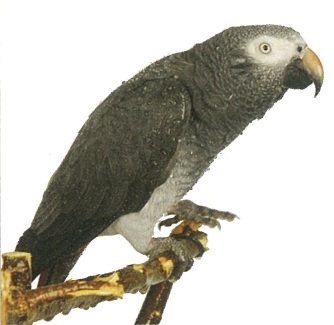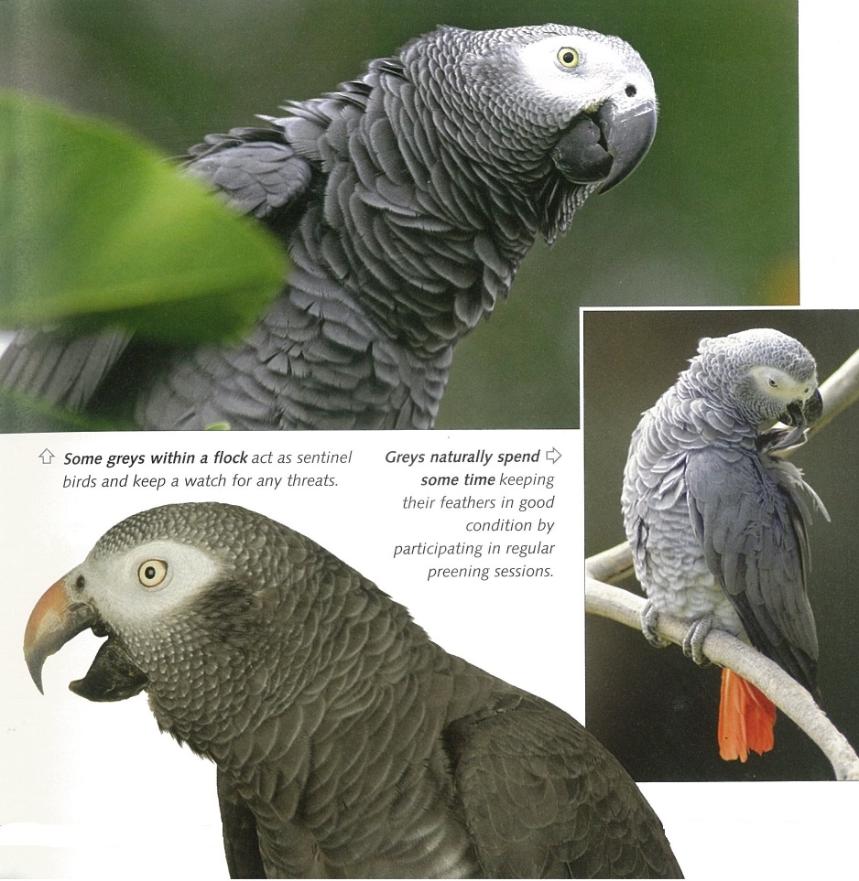When the feeding flock includes breeding birds, these will leave and later rejoin the flock as necessary as they have to make regular trips back to their nests. But the flock as a whole may stay together throughout the day. In the afternoon the birds have a quiet 'siesta' period for an hour or two when they doze and preen as they avoid other activities in the heat of the day. Later in the afternoon and early evening they start feeding again. Following these feeding activities, they return to their roosting site, occasionally flying while it is almost dark. On most days
in tropical Africa it rains and the rain can come down in very heavy showers, so everything, including the birds gets completely drenched. The parrots actually seem to enjoy this. They will roll around in the trees as it rains trying to get the feathers wet as they open their wings to catch the rain. These daily showers are vital to help them keep
their feathers in good condition. After the rain, they spend much time shaking the excess water off, preening and tidying up their feathers. Coming from an equatorial area, there is little change in daylight length throughout the year and the birds get equal amounts (c.12 hours) of darkness and daylight each day. Greys are playful birds and indulge in mock fights and occasionally tease each other as they clamber through the trees. They live in a habitat where food is quite plentiful and although they will spend many hours feeding and flying between feeding sites,
non-breeding birds do have quite a bit of free time to play and enjoy themselves.
to make rapid decisions about whether to flee from a hawk, or just hide from the danger within the trees as the predator passes by. In their own way, the birds know that their lives depend on them being attuned to everything going on around them and they are by nature very wary birds. Greys in captivity have, of course, retained this nervous disposition.
in tropical Africa it rains and the rain can come down in very heavy showers, so everything, including the birds gets completely drenched. The parrots actually seem to enjoy this. They will roll around in the trees as it rains trying to get the feathers wet as they open their wings to catch the rain. These daily showers are vital to help them keep
their feathers in good condition. After the rain, they spend much time shaking the excess water off, preening and tidying up their feathers. Coming from an equatorial area, there is little change in daylight length throughout the year and the birds get equal amounts (c.12 hours) of darkness and daylight each day. Greys are playful birds and indulge in mock fights and occasionally tease each other as they clamber through the trees. They live in a habitat where food is quite plentiful and although they will spend many hours feeding and flying between feeding sites,
non-breeding birds do have quite a bit of free time to play and enjoy themselves.
The 'language' of greys
Greys are highly intelligent creatures and they have a large repertoire of calls and postures which they use as their 'language'. By these means they can show the other members of their flock how they are reacting to things going on around them, and what action to take on seeing a predator. Like most parrots, greys are highly vulnerable to predation and potential aggressors include hawks, mammals (including humans) and reptiles. They have a range of calls which they use depending on the nature of the threat and the proposed action to take. The flock may haveto make rapid decisions about whether to flee from a hawk, or just hide from the danger within the trees as the predator passes by. In their own way, the birds know that their lives depend on them being attuned to everything going on around them and they are by nature very wary birds. Greys in captivity have, of course, retained this nervous disposition.

<-- Wild greys get drenched every day and pet birds need to be sprayed to maintain feather condition.
While the natural repertoire of calls is very similar between Timneh greys and African greys, there are some differences between the two types. -->
While the natural repertoire of calls is very similar between Timneh greys and African greys, there are some differences between the two types. -->
